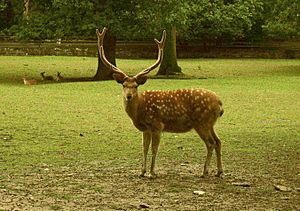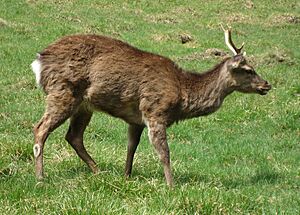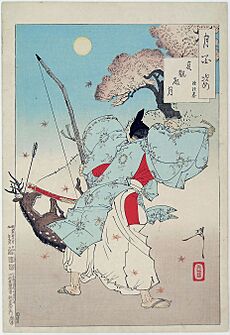Sika deer facts for kids
Quick facts for kids Sika deer |
|
|---|---|
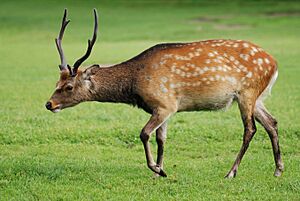 |
|
| Male (stag) in Kadzidłowo, Poland | |
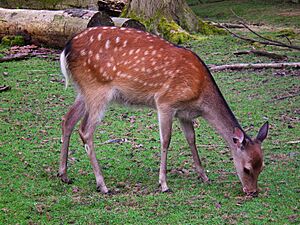 |
|
| Female (hind) in the Wildpark Alte Fasanerie, Hanau, Germany | |
| Conservation status | |
| Scientific classification | |
| Genus: |
Cervus
|
| Species: |
nippon
|
| Subspecies | |
|
See text |
|
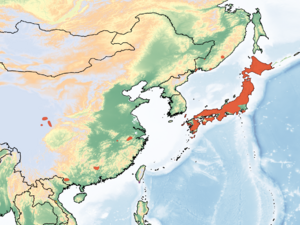 |
|
The sika deer (Cervus nippon) is also known as the Northern spotted deer or the Japanese deer. It is a type of deer that originally lived in much of East Asia. Over time, it has been introduced to many other parts of the world.
In the 1800s, sika deer were hunted so much that they almost disappeared. But thanks to protection laws in the mid-1900s, their numbers grew quickly from the 1950s to the 1980s.
Contents
What's in a Name?
The name "sika" comes from the Japanese word shika (鹿), which means "deer." In Japan, people call this animal the "Japan deer" (ニホンジカ, nihonjika).
In China, it's known as the "plum blossom deer" (梅花鹿). This is because its spots look like the flowers of a plum blossom tree.
Sika Deer Family Tree
The sika deer belongs to a group of deer called Cervus. These are known as "true deer." Other famous members of this group include the red deer found in Scotland and Europe, and the wapiti (or elk) from North America and Asia.
Scientists have learned that deer in the Cervus group can sometimes have babies together, creating hybrids. For example, in the Scottish Highlands, sika deer that were brought there have mixed with the native red deer. This mixing is a big concern for the natural red deer population.
Different Types of Sika Deer
There are many different types, or subspecies, of sika deer. However, because sika deer have mixed with other deer in some places, especially China, it's sometimes hard to know the exact status of each subspecies.
Here are some of the known subspecies:
- C. n. aplodontus (northern Honshu, Japan)
- C. n. grassianus (Shanxi, China)
- C. n. keramae (Kerama Islands, Japan)
- C. n. kopschi (southern China)
- C. n. mandarinus (northern and northeastern China)
- C. n. mantchuricus (northeastern China, Korea, and Russian Far East)
- C. n. nippon (southern Honshu, Shikoku, and Kyushu, Japan)
- C. n. pseudaxis (northern Vietnam)
- C. n. pulchellus (Tsushima Island, Japan)
- C. n. sichuanicus (western China)
- †C. n. sintikuensis (Taiwan) – This one is extinct.
- C. n. soloensis (Southern Philippines) – Probably extinct.
- C. n. taiouanus (Taiwan)
- C. n. yakushimae (Yakushima, Japan)
- C. n. yesoensis (Hokkaido, Japan)
What Sika Deer Look Like
Sika deer are special because they keep their spots even when they grow up. The spots can look different depending on where the deer lives. Deer from mainland Asia often have bigger, clearer spots. But sika deer from Taiwan and Japan might have spots that are very hard to see. Many sika deer brought to other countries came from Japan, so they also have faint spots.
Their fur can be anything from reddish-brown to black. Some sika deer are even white! In winter, their coat gets darker and shaggier, and the spots become less noticeable. Male sika deer also grow a mane (long hair) on their necks during winter.
Sika deer are medium-sized animals. Males are usually much bigger than females. They can stand from 50 to 110 centimeters (about 20 to 43 inches) tall at the shoulder. Their body length can be from 95 to 180 centimeters (about 37 to 71 inches). Their tails are short, about 7.5 to 13 centimeters (3 to 5 inches) long.
The largest type of sika deer is the Manchurian sika deer. Males often weigh between 68 and 109 kilograms (about 150 to 240 pounds). The largest males can weigh up to 160 kilograms (about 350 pounds)! On the other hand, the Japanese sika deer is smaller. Males weigh 40 to 70 kilograms (about 88 to 154 pounds).
All sika deer have a compact body and slender legs. They have small, wedge-shaped heads. When they get scared, they often show a bright, flared patch of white fur on their rump, similar to an American elk.
Male sika deer (stags) have strong, upright antlers. These antlers can grow from 28 to 45 centimeters (about 11 to 18 inches) long, and sometimes even over 80 centimeters (31 inches), depending on the subspecies. Females have two small, black bumps on their foreheads instead of antlers.
Behavior and Life Cycle
Sika deer can be active during the day. But in places where there are a lot of people, they often become more active at night. In mountainous areas like Japan, they might move to lower elevations in winter to find food and shelter.
Some sika deer live alone, while others live in groups of only males or only females. Large groups gather in autumn and winter. Males usually live alone for most of the year, but sometimes form small groups with other males. Females with young fawns only form groups during the birthing season. Sika deer are very vocal and can make more than 10 different sounds, from soft whistles to loud screams.
During the mating season, called the rut, male sika deer become territorial. This usually happens from early September to November. They try to keep a group of females (a harem) in their territory. Males mark their territory by digging shallow pits in the ground with their front feet or antlers. They then urinate in these pits, which gives off a strong, musky smell. Fights between rival males can be intense and sometimes even deadly as they use their hooves and antlers to fight for territory.
The female deer is pregnant for about seven months. She usually gives birth to one fawn, which weighs about 4.5 to 7 kilograms (10 to 15 pounds). The mother hides her fawn in thick bushes right after it's born. The fawn stays very quiet and still until its mother comes back to feed it. Fawns become independent when they are 10 to 12 months old. They can have their own babies when they are about 16 to 18 months old. In zoos, sika deer can live for 15 to 18 years, and one even lived for over 25 years!
In Nara Prefecture, Japan, some sika deer are known as "bowing deer." People think they bow their heads before being fed special "deer cookies" (鹿せんべい, shika senbei). However, deer actually bow their heads to show they are about to headbutt. So, if a person bows to a deer, the deer might think it's a challenge and get ready to charge! Deer headbutt each other for play and to show who's in charge. These deer are found all over the city of Nara and its parks because they are believed to be messengers of the Shinto gods.
Where Sika Deer Live
Sika deer live in forests in eastern Asia that have mild or warm climates. They like areas with thick bushes where they can hide. They also prefer places where the snow doesn't get too deep (usually less than 10 to 20 centimeters or 4 to 8 inches). They often look for food in small clearings within forests.
Sika deer have also been introduced to many other places around the world, including parts of Europe, the United States, and New Zealand. In these new homes, they tend to live in similar forest habitats.
Sika Deer Populations
Sika deer live in forests that are often also good for farming and human activities. This means their habitats are sometimes in areas with many people. While the sika deer species as a whole is doing well, it is endangered or has disappeared in many specific areas.
Japan has the largest native population of sika deer in the world. In 2015, the population was estimated to be over 3 million deer! This is partly because of conservation efforts and because their main predator, the Japanese wolf, died out over a century ago. Without wolves, the sika deer population grew very large. Now, in many areas, there are too many sika deer, which can harm forests and farms. Efforts are now focused on controlling their numbers. Only one subspecies, the Kerama deer, is endangered in Japan.
China used to have the most sika deer, but thousands of years of hunting and losing their homes have reduced the population to less than 1,000 wild deer. Many Chinese subspecies are believed to be extinct in the wild. Only the South China sika deer and Sichuan sika deer are known to still live in the wild in China, but their numbers are small. Many sika deer in China today are from domesticated deer that were raised by humans.
The Formosan sika deer from Taiwan was extinct in the wild for nearly 20 years. But then, deer from zoos were brought back to Kenting National Park, and now their population is growing. Similar programs are happening in Vietnam to help the Vietnamese sika deer, which is also nearly extinct.
Russia has a fairly large and stable population of the Manchurian subspecies, with about 8,500 to 9,000 deer. These deer live in a small area called Primorsky Krai.
Sika Deer Around the World
Sika deer have been introduced to many other countries. This includes places like Estonia, Latvia, Austria, Germany, Ireland, New Zealand, Australia, the United Kingdom, and many states in the United States. Often, they were first brought to parks as pets or for decoration, but then they escaped and started living in the wild.
In the UK and Ireland, there are several wild populations. Sometimes, these sika deer mix with the native red deer, which is a big worry for conservationists. Studies have shown that sika deer are among the most harmful introduced animals in Europe, causing damage to the environment and economy.
In the early 1900s, King Edward VII gave a pair of sika deer to a baron named John Montagu. These deer escaped into a forest and became the ancestors of the sika deer found in the New Forest today. They had so many babies that people had to start culling (controlled hunting) them in the 1930s to manage their numbers.
Hunting Sika Deer
In their native lands and in many places where they've been introduced, sika deer are seen as a challenging animal to hunt. In Britain and Europe, sika deer act differently from native deer when they sense danger. They often try to hide and stay still, even lying flat on their bellies, instead of running away.
In the British Isles, sika deer are considered a serious threat to new and old forests. Because of this, forestry groups often hunt them year-round to control their population.
The main natural predators of sika deer include tigers, wolves, leopards, and brown bears. Smaller predators like Lynx and golden eagles might hunt young fawns.
Velvet Antler Trade
Velvet antler refers to the soft, growing antlers of deer. It is a popular ingredient in traditional Chinese medicine. In China, sika deer were raised on farms a long time ago specifically for their velvet antlers. In Taiwan, both sika deer and sambar deer have been farmed for this purpose. Japan is one of the few places in East Asia where sika deer were not farmed for velvet antlers.
Cultural Importance
In the Shinto religion of Japan, the Sika Deer is seen as a special messenger between humans and the kami (gods or spirits).
Images for kids
-
Sika deer (stag) at Jægersborg Dyrehave in Denmark
-
In Shiretoko Peninsula, Hokkaido, Japan
-
The skull of stag displayed in the Finnish Museum of Natural History, Helsinki, Finland
-
Young male in Nara
See also
 In Spanish: Ciervo sica para niños
In Spanish: Ciervo sica para niños
- Deer of Great Britain
- Nara Park



